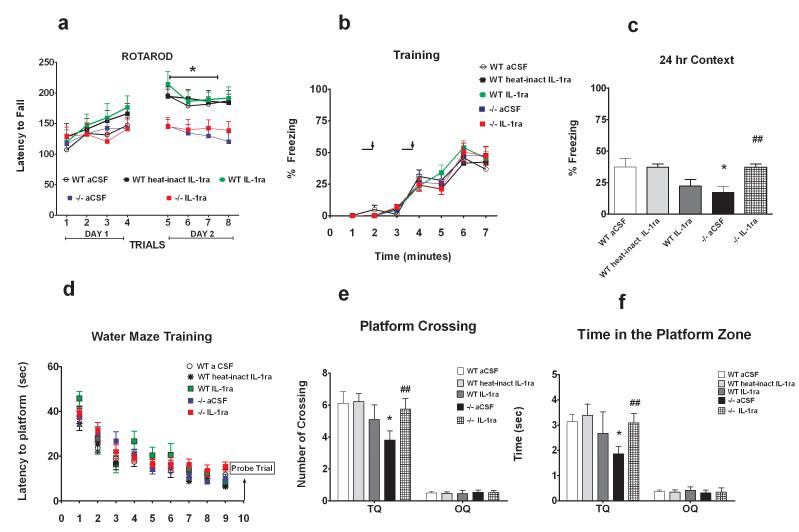Figure 7.
IL-1ra reversed the deficit in contextual fear conditioning and Morris water maze memory function induced by the loss of CX3CR1 but not the deficit in motor learning.
CX3CR1−/− ACSF(blue square) and CX3CR1−/− IL-1ra - treated mice (red square) are compared to wild-type ACSF (open circles), wild-type treated with heat-inactivated IL-1ra (black square), and wild-type IL-1ra-treated mice (green squares). Panel A shows that on the first day of training (trial 1-4) no difference between groups was observed in the learning ability on the rotarod task (a). On the second day of training (trials 5-8) all wild-type mice groups learned the rotarod task as demonstrated by their ability to remain on the rod for longer periods. Neither the CX3CR1−/− ACSF nor the CX3CR1−/− IL-1ra treated mice showed significant improvement in motor coordination with training when compared to wild-type (a);. In panel B, a tone (solid bar) was paired with a foot shock (arrowhead) at 2 and 4 minutes. Freezing behavior is shown on the day of training for CX3CR1−/− ACSF (blue square), CX3CR1−/− IL-1ra – treated mice (red square), wild-type ACSF (white circles), wild-type treated with heat-inactivated IL-1ra (black square), and wild-type IL-1ra treated mice (green square) and is comparable in all groups. CX3CR1−/− control mice showed significantly reduced freezing compared to all wild-type groups, when tested 24 h following training (c). CX3CR1−/− treated with IL-1ra (red square) showed a freezing response similar to wild type groups. Panels d and e and f show the hidden platform version of Morris water maze task. Mean latency to escape from a pool to hidden platform across training days (d). A probe test was performed on day 10 to determine the number of pseudo platform crossings in the target quadrant (TQ) compared to the opposite quadrant (OP) (e). Wild type ACSF (WT, white bar), wild-type treated with heat-inactivated IL-1ra (light gray bar), wild-type treated with IL-1ra (dark gray bar), CX3CR1−/− ACSF (black bar), CX3CR1−/− IL-1ra – treated mice (black/white grid bar). Panel F shows the time spent in the target platform zone. CX3CR1−/− ACSF (black bar) mice spent significantly less time in the target zone compared to wild-type controls (wild-type ACSF (white bar), wild-type heat-inactivated IL-1ra (light gray bar), wild-type IL-1ra (dark gray bar). CX3CR1−/− mice treated with IL-1ra spent the same amount of time in the target quadrant when compared to wild-type controls. All data are presented as mean ± SEM p < 0.01. All data are presented as mean ± SEM p < 0.01 Asterisk represents p < 0.05: CX3CR1−/− control vs wild-type controls; ## represents p<0.001: CX3CR1−/− IL-1ra vs CX3CR1 −/−.

